Dry and Mighty: How to design a dry garden
If gravel accented with a few lonely cacti and a cow skull is all that comes to mind when you think of a dry garden, it’s time to update this dusty Old West vision. Drought across the western U.S. and widespread interest in gardening more sustainably, with less water, are inspiring a renewed appreciation of dry gardens. These are, quite simply, gardens that thrive on rainfall alone or an occasional deep watering but can do without regular irrigation. Dry gardens can be surprisingly lush, layered with plants adapted to sparse rainfall, tolerant of periods of drought, and stoic in harsh conditions that make thirstier plants shrivel their toes and droop in protest.
“Water is a finite resource. It’s a commonsense thing to do,” says Julie Marcus, senior horticulturist at the Lady Bird Johnson Wildflower Center. “Also, people’s lives are busy. They don’t want to have to spend a lot of time on their yard, but they want it to look good. Plant selection is important in those cases.” Native plants, uniquely adapted to local climate, are a logical choice for dry gardens, so long as you choose those that naturally grow in dry soil, rather than along moist stream banks. (Save those for rain gardens.)
But how do you make a garden with the endurance of a camel look attractive year-round? Many dry gardens are showiest in spring, when abundant rain and pleasantly warm days entice even the most rugged plants into colorful bloom. Come summer, however, when the heat kicks in, rain clouds vanish, and spring-flowering annuals and perennials go dormant, you’ll still want your dry garden to look good.
Agarita
Evergreen plants are key players in a dry garden, providing greenery and structure that comes to the forefront when spring flowers fade. Shrubs like agarita (Mahonia trifoliolata), with its handsome, holly-like leaves, or grassy mounds of red yucca (Hesperaloe parviflora) enliven the quieter seasons. And layering in lushness from sky to soil conquers the underplanted dry garden stereotype.
Desert willow
Start with the upper layer. The shade of a tree, even an airy ornamental like desert willow (Chilopsis linearis), cools surrounding plants and soil, preserving precious moisture.
Arizona cypress, autumn sage, and Mexican feathergrass
Trees also make good windbreaks. A staggered row of Arizona cypress (Cupressus arizonica), for example, disrupts desiccating winds and shelters plants on the leeward side.
‘Tangerine Beauty’ crossvine
Let vines like ‘Tangerine Beauty’ crossvine (Bignonia capreolata) clamber atop an arbor to shade a patio.
Turk’s cap
Fill the garden’s mid-level with shrubs and masses of summer- and fall-blooming perennials like Texas lantana (Lantana urticoides) and Turk’s cap (Malvaviscus arboreus var. drummondii) to brighten the view long after the riot of spring.
Texas sedge
Sprinkle in ornamental grasses like pine muhly (Muhlenbergia dubia) for touchable texture and a long season of interest. Below this, diminutive plants like four-nerve daisy (Tetraneuris scaposa) and Texas sedge (Carex texensis) can be used en masse to carpet the garden floor — or at least make a few nice throw rugs.
Cenizo, or Texas ranger
One of the biggest challenges in designing a dry garden is battling the dreaded little-leaf syndrome. Supremely drought-tolerant plants like cenizo (Leucophyllum frutescens) tend to have tiny leaves with gray-green or silver-blue coloring, a survival mechanism that reduces water loss and reflects sunlight. An entire garden of such plants blurs into an undifferentiated scrim of fine texture.
For the cure, seek out drought-tolerant plants with bold foliage for contrast. The oval, flat pads of spineless prickly pear (Opuntia ellisiana) and sword-shaped leaves of Havard agave (Agave havardiana) stand out amid fine-textured plants, each complementing the other. For an even bigger pop, choose a bold-leaf plant with colorful foliage, like yellow-striped Yucca filamentosa ‘Color Guard’.
American agave, bamboo muhly, and woolly stemodia
A dry garden benefits, perhaps more than any other style, from creatively evoking the idea of water with plants and rocks. A silvery pool of woolly stemodia (Stemodia lanata) visually cools the garden, while an undulating river of ornamental grasses — try ‘Blonde Ambition’ blue grama (Bouteloua gracilis) — creates a sense of watery movement.
On slopes, a cascade of half-buried boulders and flat ledgestones becomes a dry waterfall; on flatter ground, a meandering shallow trench filled with varying sizes of river rock makes a convincing streambed. Evoking water without using any is a dry-garden sleight of hand that goes all the way back to the Japanese Zen garden tradition, and it’s just as magical in today’s dry gardens.
Let your creativity flow instead of the hose. A dry garden filled with carefully chosen, hard-working plants can be as beautiful as a more-pampered garden. And in making one you’ll have the satisfaction of knowing you’re saving water for a rainy day.
How to Create Your Xeric Garden
“Your garden should not die when the power or water is shut off,” says Phoenix landscape architect Steve Martino. Using dry-adapted native plants is key to creating a garden that isn’t tethered to the hose, but you can’t just plant them and walk away. Even tough natives need some TLC when they’re getting established. To ensure their success, follow these guidelines when making your dry garden.
MATCH PLANTS TO PLACE
Being “native” does not necessarily make a plant suitable for a dry garden; seek out natives from your region that require good drainage or grow naturally on dry, rocky slopes and that prefer the same sun or shade conditions as your garden offers. If your yard is consistently moist, forget about making a dry garden except in containers. Plant needs must match the site. Minor soil amendments can be useful, however. If your soil contains a lot of clay, add compost and decomposed granite to loosen soil and give your plants better drainage.
PLANT ON BERMS OR IN BASINS
Dry-loving plants can be susceptible to rot during periods of heavy rain if they lack sharp drainage such as they’d enjoy on a slope or in rocky soil. To keep their crowns dry, try planting on berms built up with gravelly soil. Shape a berm so that it curves in a gentle arc and merge it with the larger garden in order to avoid the “burial mound” look of a berm plopped in the middle of a lawn. In drier climates, where rot is seldom a concern but thirst is, harness rainwater by planting in broad, shallow basins. Such basins collect rainwater, preventing it from simply running off the surface and allowing it to soak deeply into the soil, nourishing plants’ roots.
KNOW WHEN TO PLANT
Plant shrubs and trees in autumn rather than in spring. They can grow their roots all fall and winter (in mild climates) without the stress of summer heat and drought. By the time warmer weather does roll around, they’ll be primed to put on new top growth.
Many native perennials can be planted in fall too. Some, however, like blackfoot daisy (Melampodium leucanthum), dislike winter moisture and may rot if they aren’t well-established; plant these in spring. Of course, climate varies considerably across the country, so follow appropriate planting instructions for your region and your particular plants.
WATER REGULARLY TO ESTABLISH
A common mistake in dry gardening is thinking you can plant it and forget it. But even the most xeric — i.e., dry-loving — plant needs regular water to get established. Horticulturist Julie Marcus agrees. “I’ve heard people say [after losing a plant], ‘I thought that was supposed to be one of those zero plants.’ But it has to be established before it can be xeric.” She advises watering trees and shrubs regularly for the first two years after planting; perennials for one year. Over time, lessen the frequency of irrigation, giving an occasional deep soaking only during unusually hot, dry periods. In dry-summer, wet-winter Mediterranean climates like the West Coast, established natives prefer to receive moisture during winter, not summer.
FINISH WITH MULCH
Bare soil dries out quickly, stressing plants. Give your dry garden a leg up by mulching to preserve soil moisture. An inch of mineral mulch or one to two inches of wood mulch keeps soil cooler and roots moist. Mineral mulches like decomposed granite and pea gravel look best in sunny gardens that don’t get a lot of leaf litter, and they helpfully drain moisture away from the rot-prone crowns of certain plants. However, gravel is a perfect nursery for weed seeds, so regular weeding is essential. For dry shade gardens, shredded hardwood or pecan shell mulch looks natural and suppresses weeds too.
A version of this article first appeared in the Summer 2015 issue of Wildflower magazine under the title “Dry & Mighty.”
All material © 2006-2015 by Pam Penick for Digging. Unauthorized reproduction prohibited.


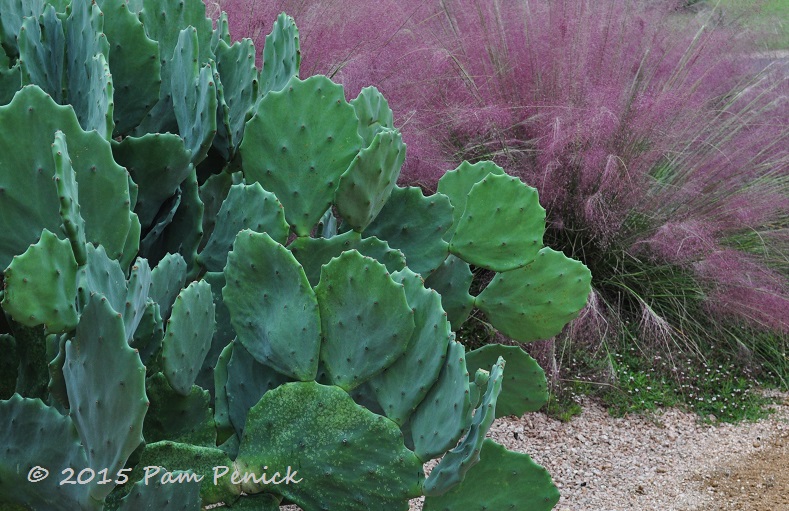
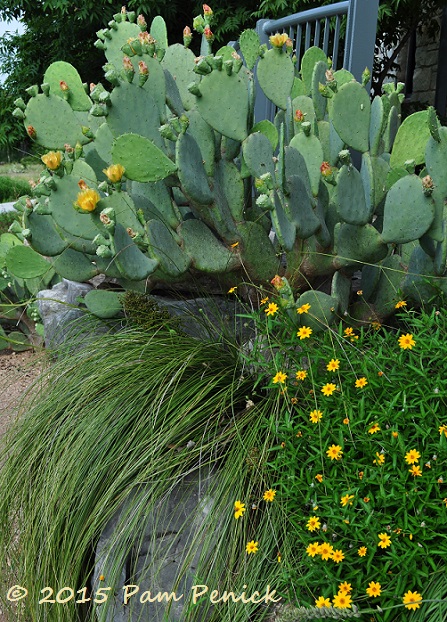
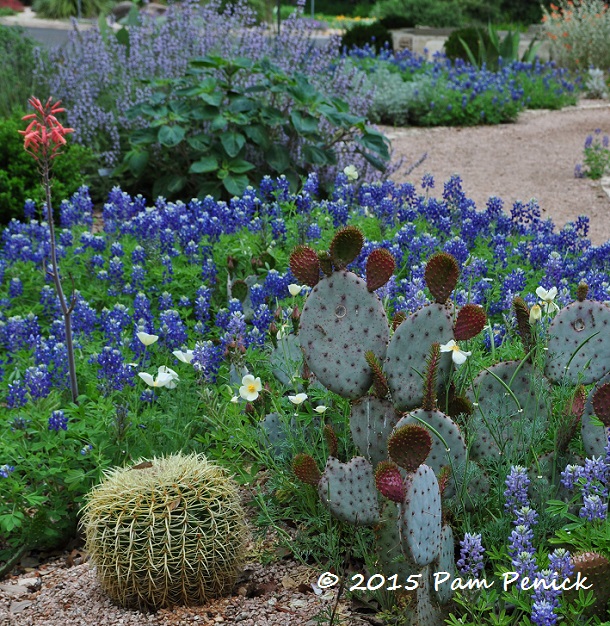
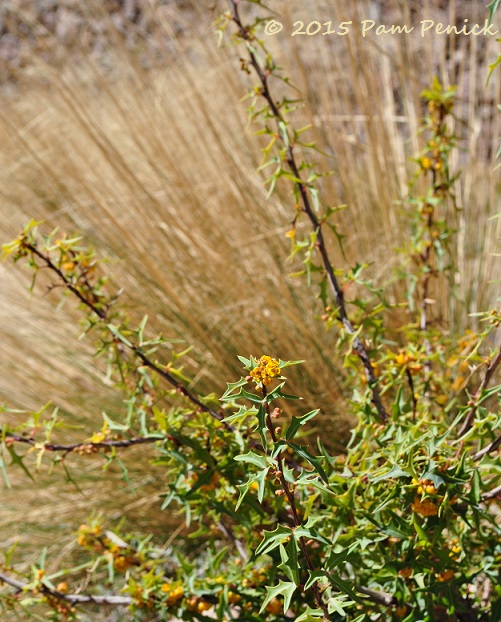
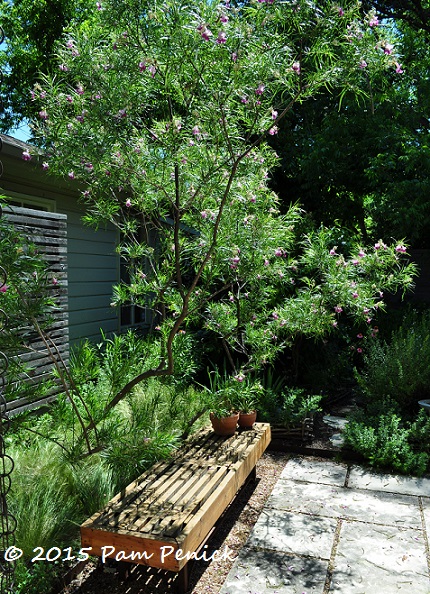
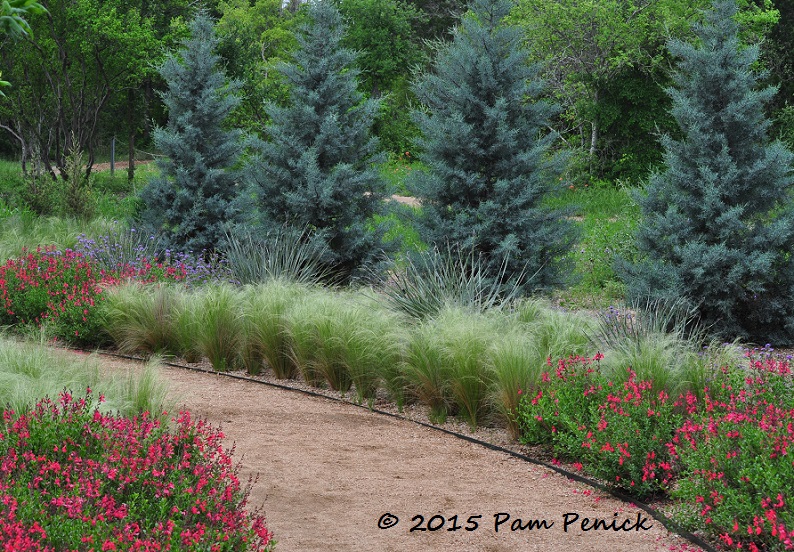
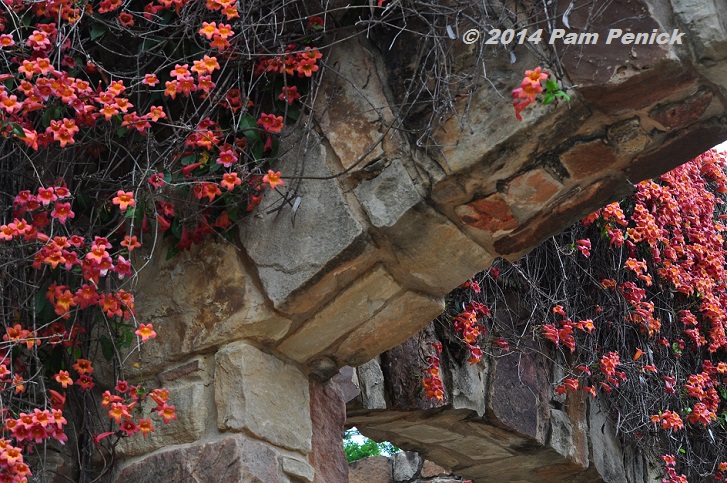
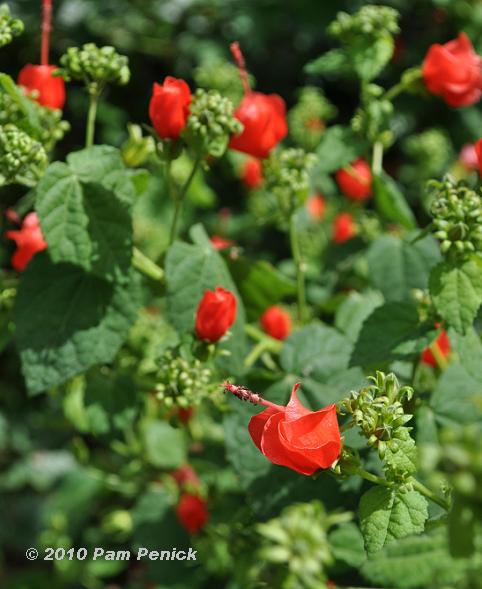
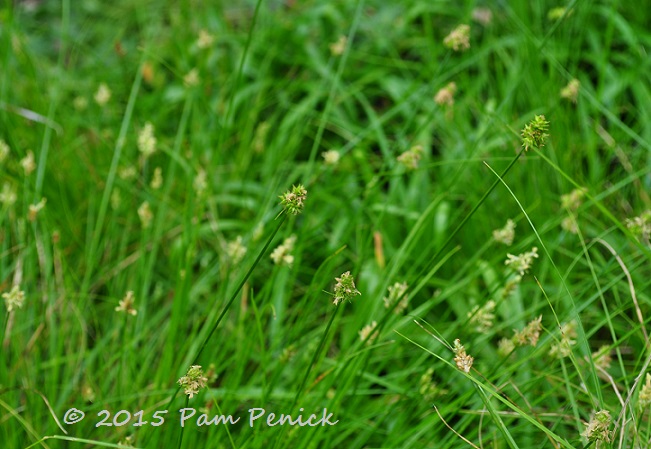
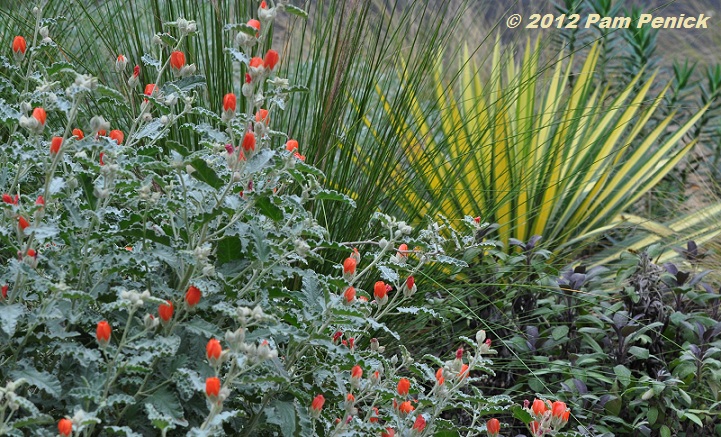
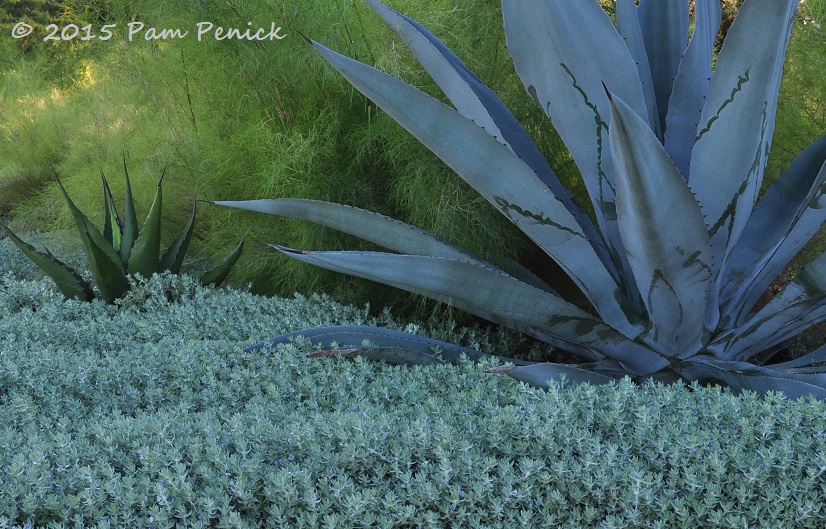
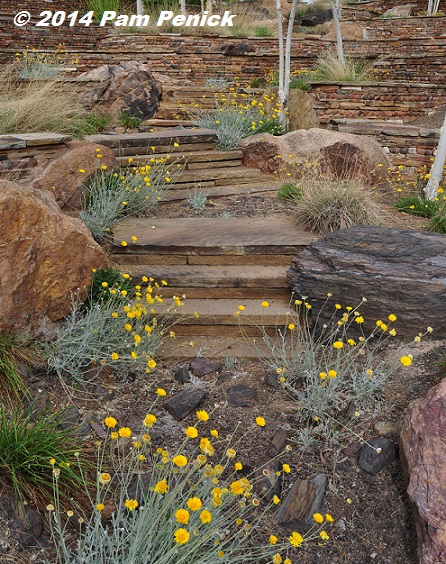
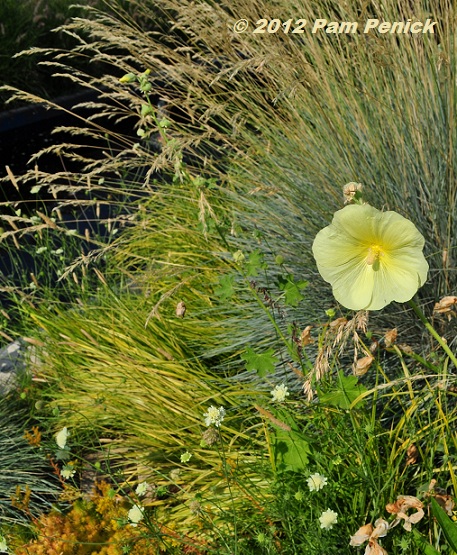
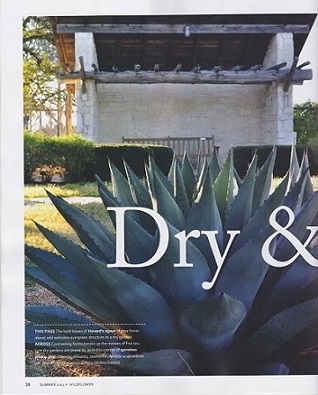
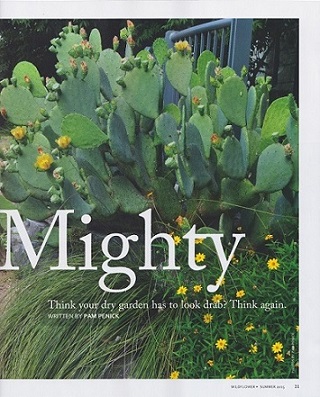
Very good advice.
And, great photos, too.
Thanks, Linda. I pulled the photos from my previous posts about dry gardens with native plants. —Pam
This is so well organized and accessible. Ticks off the boxes one by one!
If only I’d known all this back when I was first starting out replacing lawn with perennials. Current gardeners have no idea how fortunate they are to have ready access to reliable information presented specifically enough to make sense in a local context. Great article!
Thanks, Deb. I don’t usually write these kinds of articles for my blog, which is, as you know, more informal. But I do write them for magazines (and my books), and I’m glad to share them when contracts allow. I hope readers find it useful. —Pam
Could you identify the gorgeous plant in the 4th picture from the bottom? Gray foliage with orange/red flowers. Thank you
Sure, Halina. It’s gray globemallow (Sphaeralcea incana). Click through for a post I’ve written about it. —Pam
So glad you posted this here. It was too good to miss!
Thanks, Denise. —Pam
Starting with a canopy layer and moving down to the ground is a wise plant-planning process for people even in higher-rainfall climates.
This is such a clear and beautiful guide that I want to share the link widely.
It seems likely many of us will have more intense episodes of drought from here on. A lot of people have dry areas of their property, often slopes, that can really take a beating under those conditions unless designed for them. Thanks so much for the work and thought that went into this.
Many thanks, Nell. Please do share the link, if you like! —Pam
The Stemodia lanata is fascinating–wish it was available here.
Great post!
HB, I’m surprised it’s not. Would you like for me to send you a piece? —Pam
Great post and great advice! I’m working on turning my parents’ yard into a climate-adapted garden that can tolerate our long, dry summers, which seem to be getting longer, drier, and hotter. My main trouble is convincing them to make the initial investment to purchase the soil amendments necessary to loosen our compacted clay loam.
Your parents are lucky to have your assistance, Evan. Happy dry gardening! —Pam
Terrific post, and (for me) could not have come at a better time, as I rearrange the pots and put a few things in the ground this fall. That Opuntia ‘Old Mexico’ in the first photo is the nicest I’ve ever seen… the entire post is one I-need-this plant after another :~) Thanks again for a great article.
I’m so glad you enjoyed it, Luisa! —Pam
Great advice, beautifully presented. It’s timely too as I’m hard at work preparing the areas formerly occupied by sod for planting – I’m racing the clock to finish at least the back before El Nino arrives.
I hope you make it, Kris, and I especially hope you get a nice rainy winter this year. —Pam
Love the article. I’ve been trying to this in an area that 98% of the time is full sun, but when it storms it is part of a drainage easement. Much has grown there but the prickly pears are looking and feeling slightly mushy on squeeze.
Sounds like you’re having a lot of success despite the prickly pear’s pouting, Mike. Dry gardens that occasionally flood can be tricky. —Pam
Great info Pam. Perfect timing. I will be using some of your info on a presentation than I am preparing for my talk next week. Will credit you of course. Wish we can find those plants you mentioned in California. They are not readily available.
I’m glad you find it useful, Laura. Thanks for sharing my site with your audience, and if you have a chance, I’d love a mention of my upcoming book, The Water-Saving Garden, which will have more dry-gardening ideas!
As for the plants I mentioned, all are Texas or U.S. Southwest natives — because that’s where I live and garden, and so I know those plants well. They’re not necessarily appropriate for other climates. My goal was to give tips on the kinds of plants to look for and how to arrange them, rather than provide a broad plant list. Locally dry-adapted or native plants are your best bet, as I’m sure you’ll agree. —Pam
Excellent Pam ! You clearly show good design is possible when one considers the right plant for all elements of the climate.
Thank you, Saxon. Did you notice my mention of dry-summer climates? Your advocacy has resonated with me. —Pam
Another must-have Penick book to add to the library!
Just an article, Ricki. 🙂 I’m glad you enjoyed it! —Pam
Possibly your most beautiful post EVER! Thank you for sharing these gorgeous photos and gardens! Wonderful inspiration.
I’m thrilled by the positive response, Cloverann. Thank you so much! —Pam
Great article – thank you. I wish both Bamboo muhle and Stemodia were available here – they make a smashing combo, especially with that Agave.
Anna, I’m glad you enjoyed it! —Pam
A late, but important comment. For those with dogs, I suggest caution with pecan shell mulch. I found my dogs eating the shells because of a retained pecan scent. Please be aware of the potential for broken teeth, cut gums, or internal injuries.
No harm in exercising caution. It seems to me, however, that pecan shells aren’t any more likely to injure a dog than sticks or oak acorns, which my own dog likes to nosh on. —Pam
Perhaps, but the shells have pointy edges, which I think is a valid concern. I’m always reminded just how pointy whenever I’m picking shells out of the soles of my flip-flops, haha.
Aside from that, I prefer pecan shell mulch. It’s very attractive and long-lasting; on a very sunny day it’ll “cook” and have a faint scent of pecan pies. The only downside I’ve noticed is it becomes slightly reflective as it ages, so it can be harsh on the eyes in full sun.
On a different note, every picture in this post is absolutely wonderful. It’s no wonder why I use your blog as a tool when researching native plant images. Thanks for both your time and effort.
Good points on the mulch, Paulo (pun intended). Thanks for reading Digging! —Pam